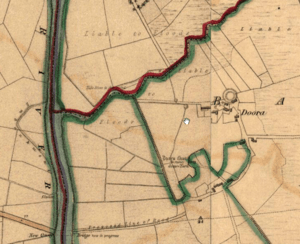Doora Church facts for kids
Quick facts for kids Doora Church |
|
|---|---|
| St Brecan's | |
| 52°50′25″N 8°57′38″W / 52.840324°N 8.960577°W | |
| Country | Ireland |
| Denomination | Roman Catholic |
| History | |
| Status | Ruined |
| Founded | c. 500 |
| Founder(s) | Saint Brecan |
| Specifications | |
| Materials | Stone |
| Administration | |
| Parish | Doora, County Clare |
Doora Church (in the Irish language: Irish: Teampull Dúrain), also known as St Brecan's, is an ancient ruined church in the parish of Doora, County Clare, Ireland. People believe it might have been built around the year 500 AD. Over the centuries, it has been changed and rebuilt many times.
Contents
The Story of Doora Church
The church was probably founded by Saint Brecan more than 1,500 years ago. If this is true, it would have been one of the first and most important churches in the County Clare area.
Historical records mention the church in the year 1189, calling it Durinierekin. Saint Brecan also started another church called Carntemple, which is about two miles away.
The church is located in a townland called Bunnow. It sits about 300 meters east of the River Fergus, across from the town of Ennis. An old map from 1842 shows the church was already in ruins by that time.
What the Church Looks Like
Even though it's a ruin, we know a lot about Doora Church from descriptions written by experts who studied it long ago.
Size and Shape
In 1839, scholars John O'Donovan and Eugene O'Curry measured the church. They found it was about 59 feet long and almost 24 feet wide on the inside. They noted that the church was very old but had been remodeled.
Walls and Doorways
The west wall of the church is mostly gone. The south wall has a large doorway, but it is very damaged. Above this doorway, there is a stone with a carving of an animal's head.
The north wall has a very old doorway made with huge stones, a style sometimes called "cyclopean." This doorway once led to a side room, but only faint traces of that room remain.
Windows and Carvings
The church has several interesting windows.
- South Wall: This wall has two windows. One is very old with a rounded top. Another was added later to match the first one. Above the older window is a carving of what looks like a large dog, possibly an Irish wolfhound.
- East Wall: The east wall has two beautiful windows, also with rounded tops. They were made from a special stone called grit. One window is older than the other. When the church was remodeled, builders tried to make the new window look like the old one.
A Mix of Old and New
Experts believe that the church was changed a lot over the years. The east wall was completely rebuilt. Originally, it probably had only one window in the middle. Later, that window was moved and a second one was added next to it.
Parts of the north and south walls are from the original building, but other parts were rebuilt later. This mix of styles shows how the church was used and cared for over many centuries.
The Church Today
The church has not changed much since the antiquarian Thomas Johnson Westropp described it in 1900. He noted its ancient stonework and the different ages of its windows. As of 2015, most of the ruin was the same, though a stone arch from one of the windows had fallen. The building remains a fascinating look into Ireland's early Christian history.
See also
- Carntemple, another ruined church nearby



